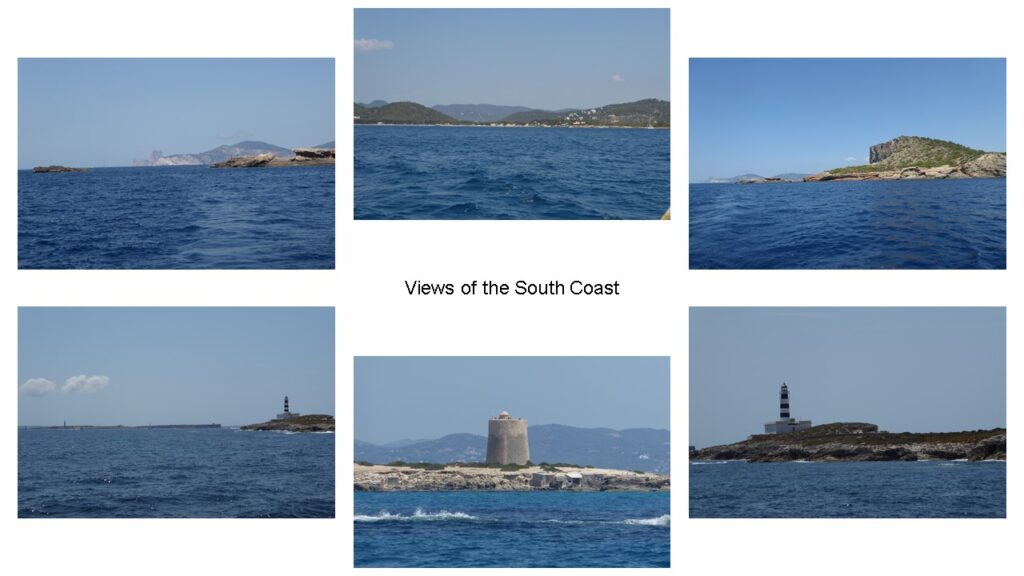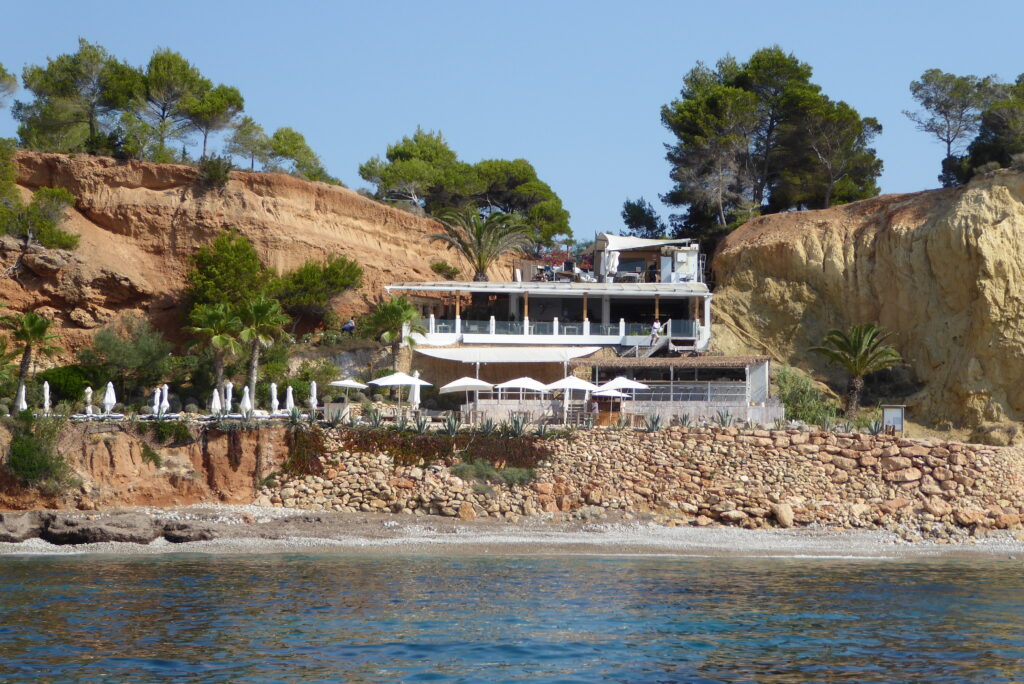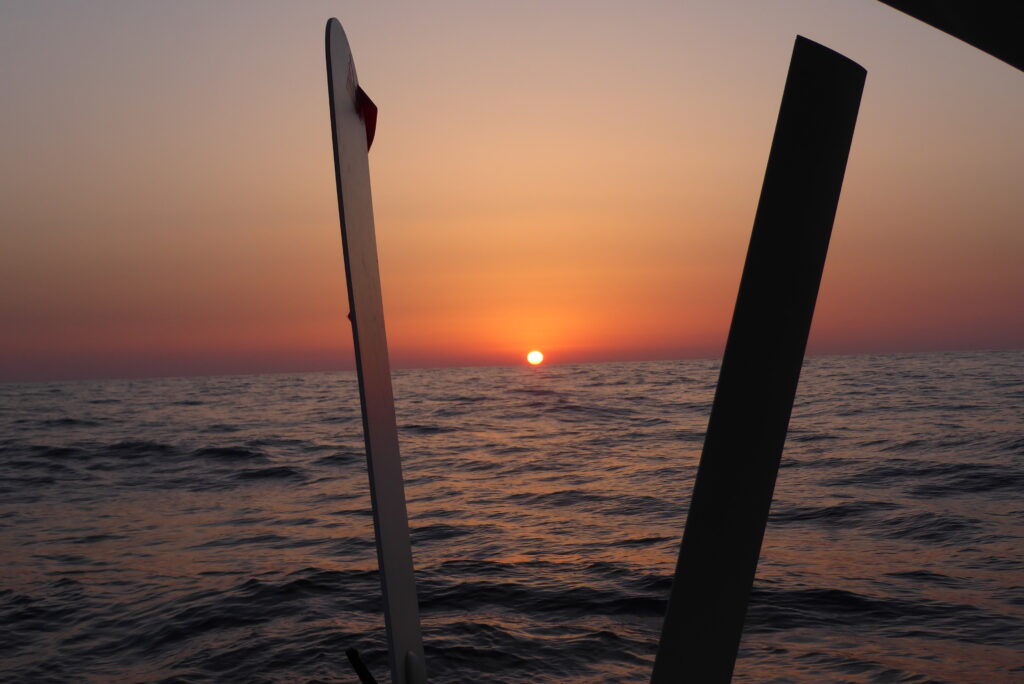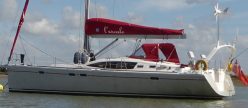Sunday 19 – Monday 27 July
We enjoyed a lazy day at anchor on Sunday, before loading the bikes and panniers one set at a time into the tender to land on a beach of very soft, very hot sand on Monday morning. The bikes were built, the sand brushed off and panniers clipped on, ready to explore some of the Rutas Verdes (Green Routes) of the island of Formentera. These are occasionally tarmacked roads, but more often sandy tracks weaving among gently rural scenery, vineyards and olive groves. Coming across a track closed while a large digger excavated a hole in the road, completely blocking it, we were touched when the driver backed to one side and his colleague beckoned us through with a cheerful wave. We made our way to the centre of the island and the main town of Sant Francesc Xavier, known locally as San Francisco. This is a more substantial town, where we found a good lunch at a pavement table on a pedestrianised street, and around the corner a slightly better stocked supermarket.
The climb back up the hill to cross the island back to ‘our’ beach seemed surprisingly less arduous than the steep descent had been, and we found our way back to the shoreline, seeing no more green lizards on the boardwalk after the four Mate had spotted earlier in the day in a brief lull in human traffic. She cooled down with an icecream from the beach bar while Skipper nobly did the double journey back to l’escale with all the gear.
On Tuesday we had a lovely reach under genoa back up to Porroig, again making water en route. This time we opted for the superyacht anchorage in the Northern corner of the bay, where we were careful to lie the anchor and chain only over sand. The following two days were extremely hot, resulting in Mate catching the sun on her back as she nobly attended to laundry detail. It was our turn to provide the day’s entertainment in the anchorage, when a bedsheet pegged out to air was whipped off the line by a rogue gust, and promptly unceremoniously dumped onto the seabed some five metres down. Once its absence was noticed and location discovered, the rescue mission soon extended to a neighbouring Spanish yacht after both our crew tried and failed to dive deep enough to retrieve it. The two caballeros that swam gallantly to the rescue had an apparently practised technique of free diving with one hand holding the nose to mitigate the effects of the pressure of salt water, while the other arm stretched down to grab the fabric and bring it back to the surface. A bottle of local red as a thank you for their efforts seemed a small gesture of our gratitude…and yes, the sheet went back into the wash.

On Friday we set off again, around the Southernmost tip of Ibiza, negotiating a passage close to the rocky islands off Punta Portas, and through the busy shipping lanes of ferries and large speedboats that rush between Ibiza Town and La Savina, the ports of the Islas Pityusaes, the Pine Islands, for their fragrance from the sea. We set the genoa mostly for show in a light and variable F1-3 breeze, again making water…until Mate suddenly heard water gushing from a hole on the port side of the hull. The bilge pump alarm was also sounding, indicating that the automatic pump had been triggered into action by water under the floor inside the boat. Skipper hastened below to discover the tech room (port stern cabin) floor awash with salt water, and discovered a considerable leak in the water maker plumbing, caused by the loosening and subsequent detachment of the pressure gauge pipe fitting. Having shut down the watermaker, he spent the next couple of hot, sweaty, uncomfortable hours clearing and mopping up, while Mate remained at the helm, trying and failing to make the genoa fly.

Although we had been aiming for Santa Eulària des Riu, we decided to stop at Cala Castellá, between Roca Llisa and Cap des Llibrell, just before the famous Cala Llonga (readers familiar with Welsh may be able to get their mental tongue around these ‘ll-s’, but in Spanish they are pronounced as ‘y’ – even more unpronounceable?) We were welcomed into this very attractive bay by l’escale’s first dolphin encounter in the Mediterranean, albeit only a brief glimpse. The cabin temperature now reading 35˚C, we relaxed between stages of repairing the watermaker, until the day visitors had departed and we could re-anchor on a larger patch of sand under the Western cliffs. As dusk fell, the lights of the restaurant at the head of the cala illuminated a very pretty scene, which research revealed was Amante, a fine dining establishment with a very interesting menu, prices omitted. One of those where if you have to ask how much, you can’t afford it?
As another weekend came around, we set off once more for Santa Eulària, peering into Cala Llonga as we passed, and were glad we hadn’t attempted to stop there the night before – it’s very ‘developed’ with unattractive hotel buildings, and a narrow space for boats. After nearly touching bottom searching for an anchoring spot outside the marina at Santa Eulària, avoided by the marina’s marinero kindly warning us off from his fast RIB, we tucked into a suitable spot between an Ovni and a small local fishing boat. We landed the tender on the beach to stroll around this attractive town, surely the most grown-up resort on Ibiza. Up the hill we found the Puig de Missa, a beautiful fortress church, dating from 1568 and simply painted inside and out in white, with its 17th Century multi-arched entrance porch. Gazing down to the valley below, we picked out the line of the only river in the Balearics, whose constant flow of water enabled the local flour mills to operate at a time when bread was one of the island’s staple foods. We also spotted the Pont Vell (Old Bridge), whose first records date back to 1720. This bridge was the main entrance to the town until 1918, when the Pont Nou (New Bridge) was built.

We followed a different path back down to sea level, past attractive casas with colourful gardens clinging to the hillside, and found ourselves on the Passeig Marítim, where the evening paseo (promenade, stroll) was in full swing among restaurants, ice cream parlours and stalls of artisan merchandise. Having read about the fameliars, small goblins from Ibiza’s mythology who, according to legend, are born from the stem of a grass that only grows on the eve of Saint John’s Day under the old bridge of Santa Eulària des Riu, and who must be entertained and well fed to prevent them from getting into any kind of mischief, Mate was pleased to spot some of their sculptures along the way.

framed by the WindPilot
After a rolly night at anchor, we went ashore once again to walk a little out of town to a decent-sized Mercadona supermarket, fortunately open on Sundays. We returned following the shore as far as possible, before skirting the grounds of a smart-looking hotel and finding ourselves back at the beach. It is always a relief to find l’arrêt patiently waiting where we left her. Later that afternoon, with the cabin temperature at 33˚C, we headed Northeast and North, passing between the island and another offspring, Tagomago, along more rugged and uninhabited coastline, to find ourselves on the seaward side of Punta Moscarter and the stripy lighthouse of our first few days here. As Portinatx itself was very busy and crowded, we continued into the larger, more open bay immediately West, and tucked into Cala Xarraca. Apart from touching an uncharted rock in 2.5 metres of water with 1.5 metres of draft, we enjoyed a comfortable last two nights and day between on Ibiza. Our total cruising distance was 207 Miles.
